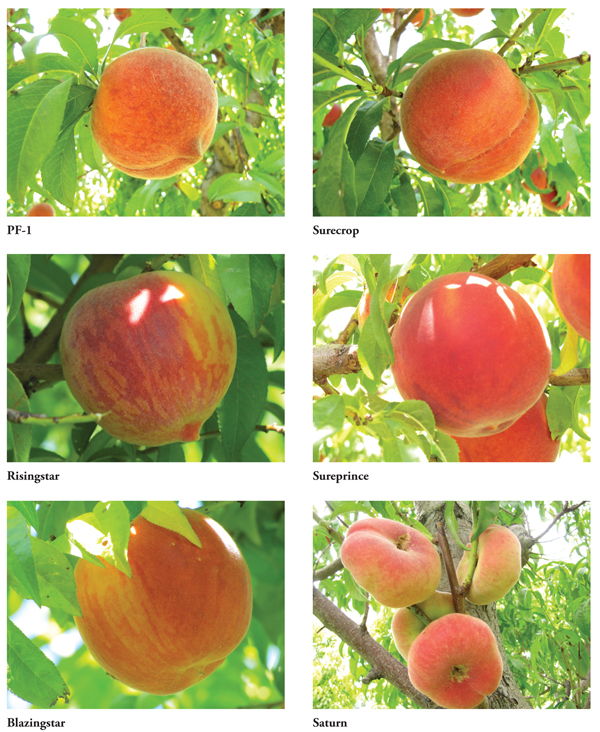Peach Cultivar Evaluation in Northern New Mexico
Research Report 782
Shengrui Yao and Ron Walser
Agricultural Experiment Station, College of Agricultural, Consumer and Environmental Sciences
Authors: Respectively, Assistant Professor, Sustainable Agriculture Science Center at Alcalde; and Urban Small Farm Specialist (retired), Agricultural Science Center at Los Lunas, New Mexico State University. (Print friendly PDF)
Abstract
A peach trial with 20 cultivars was established at New Mexico State University's Sustainable Agriculture Science Center at Alcalde in 2001 with a perpendicular V training system at 6 x 15 ft spacing. Trees were threatened by late frosts each spring around blooming time and fruitlet period. Peach flowers were all killed with a temperature of -11.9°F on February 3, 2011, but vegetative buds were undamaged. 'Sureprince', 'Challenger', and 'Saturn' were the earliest to bloom, while 'China Pearl', 'Encore', 'Intrepid', and 'Risingstar' were the late bloomers among the 20 cultivars tested. 'Blushingstar', 'Surecrop', 'Blazingstar', 'Challenger', 'Nectar', 'Contender', 'Coralstar', 'China Pearl', 'PF-27A', 'Encore', and 'Crimson Rocket' all produced well in 2012. Peach twig borer and peach tree borer are the two major pests in northern New Mexico. Peach twig borer could be managed by summer oil and spinosad sprays, and Isomate DUO PTB was promising in controlling peach tree borer. Overall, 'PF-1', 'Surecrop', 'Blazingstar', 'Intrepid', 'Contender', 'Blushingstar', 'China Pearl', and 'Encore' are recommended for northern New Mexico. Frost protection equipment is necessary for a reliable peach crop in northern New Mexico.
Introduction
Peach (Prunus persica) is a challenging crop to grow in New Mexico because of frequent late frosts and occasional winter freezes. With global weather changes, fruit tree flowers/fruitlets are frost killed with greater frequency today than in the past (Yao et al., 2011). Peach is a favorite fruit, and growers are requesting cultivar and pest management information. With this in mind, a peach trial with 20 cultivars was set up at the NMSU Sustainable Agriculture Science Center at Alcalde in 2001. We report the summary of this 11-year trial.
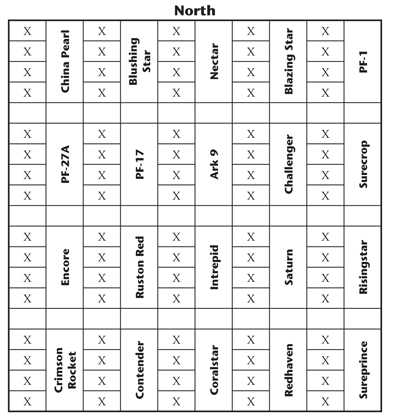
Figure 1. Peach cultivar trial planting map.
Materials and Methods
In spring 2001, 20 peach cultivars on 'Halford' rootstock with four trees per cultivar at a spacing of 6 x 15 ft were planted at the NMSU Sustainable Agriculture Science Center at Alcalde, NM (elevation 5700 ft; Figure 1). Trees were trained as a perpendicular V system (DeJong et al., 1994) and managed as certified organic production. New Zealand white clover was seeded as a cover crop between rows after tree planting, and later became a mixture of clover and volunteer grasses. Vegetation was mowed as needed and cut with a weed trimmer around the trunks. Under-canopy sprinklers were installed for routine irrigation and spring frost protection. Trees were irrigated weekly or as needed during the growing season.
Pests and diseases were generally monitored weekly during the growing season. Peach twig borer was monitored with pheromone traps and controlled with summer oil and spinosad (Entrust) sprays. Peach tree borer was treated with parasitic nematodes in 2008—2010 and pheromone disruption (Isomate PTB Dual) in 2011 and 2012 (Grasswitz and Yao, 2012).
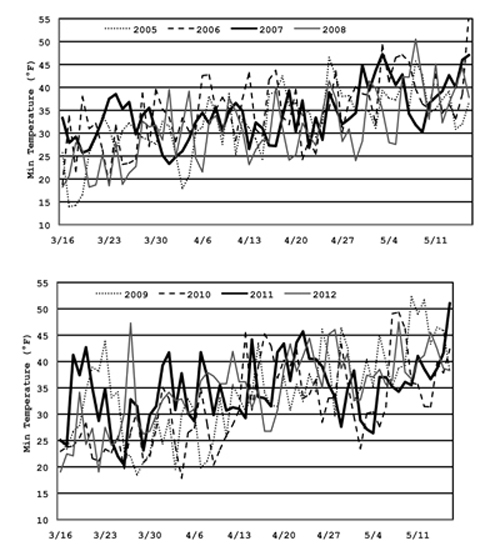
Figure 2. Daily minimum temperatures from March 15 to May 15 of 2005—2012 at Alcalde, NM.
Temperatures were monitored daily around blooming and post-blooming periods for late frost management. Sprinklers were turned on during cold nights for late frost control. Phenology was recorded for 2004, 2010, and 2012. Crop yield was visually rated in 2010, and total yield and average fruit weight of 30 fruits were recorded in 2012.
After freezes on January 1 (-7.2°F) and February 3 (-11.9°F), 2011, flower buds from selected cultivars were cut open with a razor blade and survival rate was evaluated on January 10 and February 10, 2011, respectively. Flower numbers were also counted during blooming time on April 8, 2011.
Since this is not a replicated experiment, data were not statistically analyzed, but means are presented.
Results and Discussion
Weather Data
The minimum daily temperatures from March 15 to May 15 of 2005—2012 are given in Figure 2. It shows that late frosts happened quite often around blooming time (which ranges from the last week of March to the first three weeks of April) and for a few weeks after that in northern New Mexico. On March 16 and 17, 2005, the minimum temperatures were below 15°F for two consecutive days, which likely killed most of the peach flower buds at that time. For 2011, it was the freeze on February 3 (-11.9°F) that killed almost 100% of all peach flower buds (Yao, 2011). There was a partial crop for some cultivars in 2007 and 2010 and a full crop for most cultivars in 2012. For those three years, the under-canopy sprinklers were turned on when late frosts were coming in April or early May. There was no frost protection for 2008 and 2009 and also no crop for both years. In 2012, the temperature hit 27°F two weeks after full bloom, and a 17-year-old 'Redhaven' tree in a neighborhood close to the NMSU Alcalde Center was left with only 20 fruit, while the 'Redhaven' trees with sprinklers at the Alcalde Center averaged 70 lb/tree. On May 1, 2010, the temperature dropped to 23.4°F, and the sprinklers did save some peaches. Whether there was a crop or not for a specific year depended on the last frost dates, the flower bud/fruit development stages, and the level of frost protection provided. In general, the late-blooming cultivars had a better chance for a crop, while early bloomers were more vulnerable to late frost damage.
Table 1. Peach Bloom Phenology in 2004 and 2012
| First Bloom | Full Bloom | |||
| Cultivar | 2004 | 2012 | 2004 | 2012 |
| PF-1 | 3/26 | 3/27 | 4/1 | 4/2 |
| Surecrop | 3/29 | 3/29 | 3/31 | 4/3 |
| Risingstar | 3/29 | 3/30 | 3/31 | 4/6 |
| Sureprince | 3/26 | 3/25 | 3/31 | 4/6 |
| Redhaven | 3/26 | 3/27 | 3/31 | 4/1 |
| Saturn | 3/26 | 3/27 | 3/29 | 4/1 |
| Challenger | 3/25 | 3/25 | 3/31 | 3/29 |
| Blazingstar | 3/26 | 3/29 | 4/1 | 4/2 |
| Nectar | 3/26 | 3/27 | 4/1 | 4/2 |
| Ark 9 | 3/29 | 3/27 | 4/1 | 4/1 |
| Intrepid | 3/26 | 3/30 | 4/2 | 4/6 |
| Coralstar | 3/29 | 3/27 | 4/1 | 4/2 |
| Contender | 3/26 | 3/28 | 3/31 | 4/2 |
| Ruston Red | 3/29 | 3/28 | 3/31 | 4/1 |
| PF-17 | 3/26 | 3/27 | 3/31 | 4/2 |
| Blushingstar | 3/29 | 3/29 | 4/1 | 4/2 |
| China Pearl | 3/30 | 3/30 | n/a | 4/9 |
| PF27-1 | 3/26 | 3/27 | 3/31 | 4/1 |
| Encore | 3/26 | 3/27 | 4/1 | 4/1 |
| Crimson Rocket | 3/26 | 3/27 | 4/1 | 4/1 |
| Difference (days) | 5 | 5 | 4 | 11 |
Table 2. Peach Flower Bud Winter Damage in 2011, at Alcalde, NM (Yao, 2011)
| Jan. 10, 2011 | Feb. 10, 2011 | Apr. 8, 2011 | |||
| Cultivar | Total bud no. | Live buds (%) | Total bud no. | Live buds (%) | Flowers/tree |
| Blazingstar | 641 | 11 | 453 | 0.7 | 0.5 |
| PF-1 | 1,238 | 25 | 479 | 0.4 | 0.5 |
| China Pearl | 465 | 87 | 487 | 0.6 | 5.5 |
| Saturn | n/a | n/a | 428 | 0.5 | 2.3 |
| Crimson Rocket | n/a | n/a | 293 | 0.3 | 2.0 |
| Encore | 958 | 85 | 353 | 0.0 | 11.0 |
| Contender | 387 | 61 | 401 | 0.0 | 14.0 |
| Redhaven | n/a | n/a | 314 | 0.0 | 0.0 |
| Surecrop | 662 | 40 | 420 | 0.0 | 0.0 |
| Intrepid | 563 | 81 | 243 | 0.0 | 4.0 |
| Nectar | 382 | 71 | 106 | 0.0 | 1.0 |
| Sureprince | n/a | n/a | 173 | 0.0 | 0.3 |
| *The dead flower buds on February 10, 2011, included buds that died in the January 1, 2011, freeze. | |||||
Table 3. Peach Cultivar Yield in 2012 at Alcalde, NM
| Harvest date | Fruit wt (g) | Yield (kg/tree) | |
| PF-1 | 7/3/2012 | 143 | 12.1 |
| Surecrop | 7/13/2012 | 148.2 | 41.1 |
| Risingstar | 7/13/2012 | 189.8 | 11.5 |
| Sureprince | 7/9/2012 | 171.3 | 20.4 |
| Blazingstar | 7/25/2012 | 139.3 | 41.6 |
| Challenger | 7/31/2012 | 165.9 | 43.9 |
| Saturn | 7/24/2012 | 109.3 | 16.6 |
| Redhaven | 7/24/2012 | 141.3 | 32.8 |
| Nectar | 7/31/2012 | 160.6 | 30.5 |
| Ark 9 | 8/2/2012 | 121.5 | 35.0 |
| Intrepid | 8/13/2012 | 158.3 | 67.2 |
| Coralstar | 8/7/2012 | 284.1 | 47.0 |
| Blushingstar | 8/13/2012 | 158.3 | 67.2 |
| PF-17A* | N/A | ||
| Ruston Red | 8/21/2012 | 160.0 | 12.2 |
| Contender | 8/13/2012 | 165.0 | 55.0 |
| China Pearl | 8/28/2012 | 141.8 | 34.4 |
| PF-27A | 8/24/2012 | 186.0 | 32.1 |
| Encore | 9/5/2012 | 143.9 | 46.7 |
| Crimson Rocket | 8/8/2012 | 185.0 | 27.3 |
| * There was only one tree left for PF-17A |
Phenology
In 2012, the full bloom date of the earliest bloomers 'Sureprince', 'Challenger', and 'Saturn' was 8—11 days earlier than the latest bloomer 'China Pearl' (Table 1), and 'Saturn' was one of those cultivars with low yield. While spring 2012 was generally warm nationwide, the relatively cool temperatures during blooming time in 2012 extended the blooming period and the differences among cultivars, and the peach blooming date was 7—10 days earlier than 2010 (data not shown). 'China Pearl', 'Encore', 'Intrepid', and 'Risingstar' were the late bloomers among the 20 cultivars evaluated (Table 1).
Winter Hardiness
After the January 1, 2011, freeze, the flower bud survival measured on January 10 varied among cultivars, from 11% for 'Blazingstar' to 85% and 87% for 'Encore' and 'China Pearl', respectively (Table 2).
On the other hand, after the February 3, 2011, deep freeze, no cultivar had more than 1% healthy flower buds as of February 10, which was verified at blooming time with only 0—14 flowers per tree, depending on cultivar (Table 2). The few live flower buds were always either on the base of the branches or on the strong water sprouts in the upper part of the canopy, which is in accordance with previous observations (Meyers and Okie, 1986). No vegetative bud damage was observed after the temperature reached -11.9°F on February 3, 2011, at Alcalde, NM. So, peach flower buds could not tolerate -12°F even in the dormant season. 'Encore', 'China Pearl', and 'Intrepid' were hardier than 'PF-1' and 'Blazingstar'.
Yield
For this 11-year trial, there were light crops in 2007 and 2010 and a full crop for all cultivars in 2012. Trees had no crop in 2011 due to the winter freeze on February 3, 2011 (Yao, 2011). In 2010, 'China Pearl', 'Encore', and 'Blazingstar' were the best performers, while 'Saturn', 'Challenger', 'Sureprince', 'Coralstar', and 'Crimson Rocket' had no or minimal crop (data not shown). In 2012, 'Blushingstar' yielded over 65 kg fruit/tree, while 'PF-1', 'Risingstar', 'Ruston Red', and 'Saturn' yielded 10—17 kg/tree. 'Surecrop', 'Blazingstar', 'Challenger', 'Redhaven', 'Nectar', 'Contender', 'Coralstar', 'China Pearl', 'PF-27A', 'Encore', and 'Crimson Rocket' all performed well (Table 3). 'Ark 9' had reasonable yield and the fruit hung well on the tree, but the fruit quality was not desirable.
Pests
Peach twig borer and clearwing peach tree borer are the two major peach pests at Alcalde, NM. Peach twig borer was managed with pre-bloom summer oil spray plus one or two spinosad/Entrust sprays during the growing season scheduled according to growing degree days (GDD). For peach tree borer control, the parasitic nematode applications were not as effective as reported elsewhere (Shapiro-Ilan et al., 2009). There was no significant difference between treated and untreated control after three years of trial. Our arid weather could have contributed to the non-significance and made it hard for the nematodes to survive. The Isomate Duo PTB pheromone disruption was promising at Los Lunas, NM (Grasswitz and Yao, 2012). It was still ongoing at Alcalde, NM.
Cultivars
Pictures for each cultivar are presented in Figure 3. Fruits from most cultivars tasted good at Alcalde, NM, except 'Ark 9'. 'PF-1' was the earliest to mature and 'Coralstar' produced the biggest fruit among the 20 cultivars. The late-blooming cultivar 'China Pearl' had medium to small, white- to greenish-fleshed fruit, but very good quality. 'Crimson Rocket' had darker fruit color, nice flavor, and relatively larger fruit than most others. Its upright growing habit makes it desirable for home gardeners with limited space. 'PF-1', 'Surecrop', 'Blazingstar', 'Intrepid', 'Contender', 'Blushingstar', 'China Pearl', and 'Encore' are recommended for northern NM.
For peach cultivar selection, people in New Mexico need to consider not only the flavor and maturation season but also the blooming time or the cultivar's relative tolerance to late frosts. For home gardeners, selecting the late bloomers and avoiding the early ones would be a good choice. For commercial growers with wind machines and under-canopy sprinklers to raise the temperature 2—4°F during late frost periods, all cultivars are possible, but late bloomers are more reliable. With frequent late frosts plus occasional winter freezes, peach is still a risky tree fruit crop for northern New Mexico.
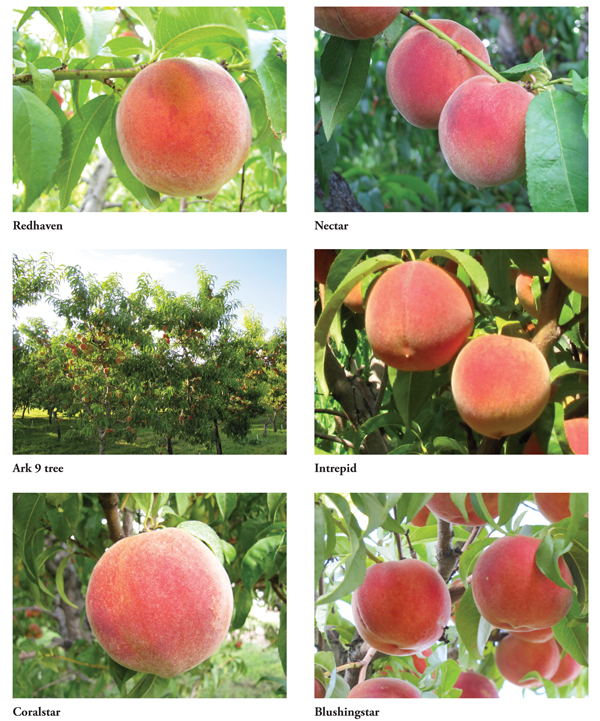
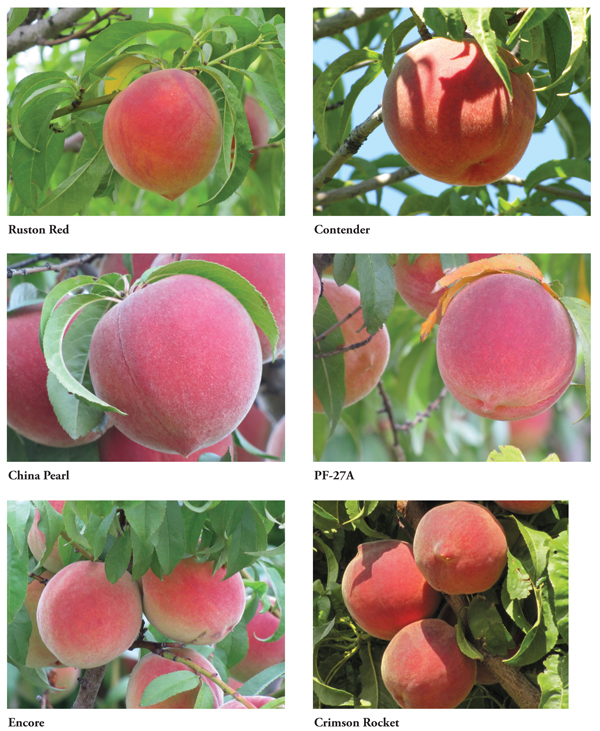
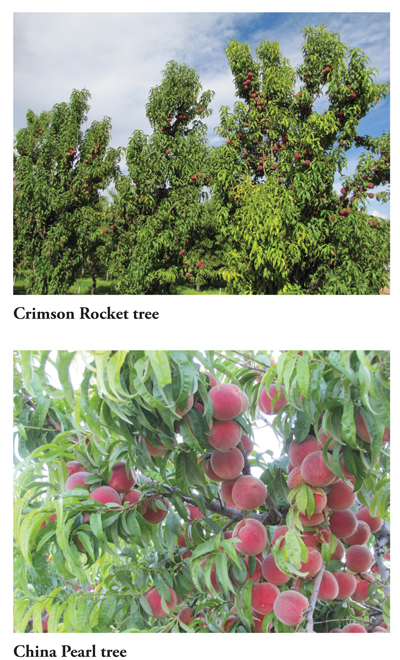
Figure 3. Peach cultivar fruit and tree pictures.
References
DeJong, T.M., K.R. Day, J.F. Doyle, and R.S. Johnson. 1994. The Kearney Agricultural Center perpendicular "V" (KAC-V) orchard system for peaches and nectarines. HortTechnology, 4, 362—367.
Grasswitz, T., and S. Yao. 2012. Control of the greater peach tree borer (Synanthedon exitiosa) (Lepidoptera: Sesiidae) in small-scale organic orchards. II International Organic Fruit Production Symposium, Acta Horticulturae (in press).
Meyers, S.C., and W.R. Okie. 1986. Low midwinter temperature injury to peach flower buds in Georgia. Fruit Varieties Journal, 40, 136—139.
Shapiro-Ilan, D.I., T.E. Cottrell, R.F. Mizell III, D.L. Horton, and J. Davis. 2009. A novel approach to biological control with entomopathogenic nematodes: Prophylactic control of the peach tree borer, Synanthedon exitiosa. Biological Control, 48, 259—263.
Yao, S., C. Martin, and R. Walser. 2011. Evaluation of eight apple cultivars and two training systems in northern New Mexico [Research Bulletin 803]. Las Cruces: New Mexico State University Agricultural Experimental Station.
Yao, S. 2011. Winter 2011 low-temperature injury to stone fruit flower buds in New Mexico. HortTechnology, 21, 767—772.
Brand names appearing in publications are for product identification purposes only. No endorsement is intended, nor is criticism implied of similar products not mentioned. Persons using such products assume responsibility for their use in accordance with current label directions of the manufacturer.
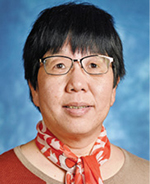
Shengrui Yao is Assistant Professor and Extension Fruit Specialist at New Mexico State University's Sustainable Agriculture Science Center at Alcalde. She earned her Ph.D. in pomology/horticulture at Cornell University. Her research and Extension work focus on tree fruit and small fruit production, conventional and organic production, and orchard floor and soil fertility management.
To find more resources for your business, home, or family, visit the College of Agricultural, Consumer and Environmental Sciences on the World Wide Web at aces.nmsu.edu
Contents of publications may be freely reproduced for educational purposes. All other rights reserved. For permission to use publications for other purposes, contact pubs@nmsu.edu or the authors listed on the publication.
New Mexico State University is an equal opportunity/affirmative action employer and educator. NMSU and the U.S. Department of Agriculture cooperating.
September 2013, Las Cruces, NM


